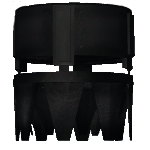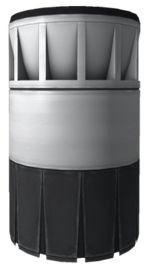J-X4 "Whiplash" Turbo Ramjet Engine
| J-X4 "Whiplash" Turbo Ramjet Engine | ||
| Jet engine by C7 Aerospace Division | ||
| Radial size | Small | |
| Cost | (total) | 2 250.00 |
| Mass | (total) | 1.800 t |
| Drag | 0.2 | |
| Max. Temp. | 2000 K | |
| Impact Tolerance | 7 m/s | |
| Research | | |
| Unlock cost | 18 000 | |
| Since version | 0.15 | |
| Part configuration | jetEngineTurbo.cfg | |
| Maximum thrust | 130.00 kN | |
| Isp | (max) | 4000 s |
| Fuel consumption | 0.66 | |
| Intake air consumption | 5.30 | |
| Thrust vectoring | 1 ° | |
| Electricity generated | 5.0 ⚡/s | |
| Testing Environments | ||
| On the surface | Yes | |
| In the ocean | Yes | |
| On the launchpad | Yes | |
| In the atmosphere | Yes | |
| Sub-orbital | Yes | |
| In an orbit | No | |
| On an escape | No | |
| Docked | No | |
| Test by staging | Yes | |
| Manually testable | Yes | |
The J-X4 "Whiplash" Turbo Ramjet Engine is an air-breathing engine. These require liquid fuel from tanks and constant supply of intake air using air intakes inside an oxygenated atmosphere. Note, intakes collect air and send it to jet engines regardless of where the intakes are on the craft; fuel, however, flows automatically only from the same stage as the engines. It is similar in appearance and function to the Pratt & Whitney J58, used on the famous SR-71 Blackbird.
Usage
Being the second air breathing engine to unlock in the tech tree, it marks a great step towards space-usability. As on all engines, thrust varies with altitude. Contrary to all rocket engines, air breathing engines' thrust diminishes with increasing height. Furthermore differing from most rocket engines, this has a real impact on usage, as the effect is far more distinct.
Contrary to pre KSP 1.0, its maximum stationary thrust is higher than that of the Basic Jet Engine, rated with 180 kN at sea level. Rising up to 4500 m the thrust drops to about 108 kN, more or less staying at this performance up to a height of about 10600 m. From there on, thrust output drops somewhat linear until the engine shuts down at about 22000 m.
As with the basic engine, thrust output also varies with speed. The big difference on this engine (as well as on the R.A.P.I.E.R.) is, that it draws a huge boost out of the airspeed, as the name already implies. Up to mach 0.2 (e.g.: still on the runway) it stays somewhat constant, being boosted by further acceleration to a maximum of about 580% at mach 3, which would be about 1000 kN at sea level! Getting even faster, thrust starts dropping, reaching zero output at mach 5.5.
The specific impulse (Isp) stays constant over the full range of application, which is a big change to KSP pre 1.0 versions. It is rated at 8000 s, which is only exceeded by the basic jet engine. However, as the thrust/height curve of this engine allows for usage in already quite thin air, it is practically comparable to the Wheesley in terms of fuel per distance traveled.
Combining the height and the speed behaviour, this engine gives remarkable thrust even at great heights as long as it moves fast enough. Practically, you need to have in mind both curves for two different reasons:
- Overpowering: from 4500m up to 10600 m thrust is nearly not reduced by height. As it is speed boosted (100%+ thrust) up to mach 5, level flight at full throttle quickly leads to disintegrating.
- Underpowering: Flying very high, the engine may have enough thrust to maintain high speed (mach 3) due to the speed boost, but getting a bit slower quickly leads to a non-stoppable deceleration as the engine gets weaker.
In conclusion this means: The engine needs thick air to get really strong, but then the craft desperately needs thin air to maintain integrity. Carefully flying at the right ascent-path, you can easily (and quickly) reach 1100 m/s at 20000 m (still rising fast), which is quite a useful base for continuing towards stable orbit with the same stage. A normal ascent path for a turboramjet spaceplane ends up looking something like this: climb at a 30 degree angle at full throttle until 10,000 meters, then nose down to 20 degrees or even 10 degrees ascent. The best compromise between angle of attack, rate of climb, and drag is reached somewhere in this range. Keep this attitude constant, even nosing down a little bit more, until the turboramjet flares out at 26km. If it flares out at a lower altitude, then more intakes are required. However, unless one is extremely lucky or extremely thrusty, the apoapsis at this point will not be out of the atmosphere (this, along with the need to make a circularization burn at apoapsis in vacuum, is why a rocket is still required for a turboramjet spaceplane). Immediately pitch up (being careful to avoid creating huge drag from an extreme angle of attack) and light up the rocket(s).
The exact altitude where you should drop the nose (trading the rate of ascent for acceleration) varies for each individual craft design, as does the optimal angle of attack in both the lower and upper phases of the ascent. Some experimentation is normally required to find the optimal ascent profile for each individual design of spaceplane.
Product description
| “ | A highly advanced turbine engine using space-grade materials for very high performance. This new model features the latest in thrust vectoring and compression technology and is designed to operate best at higher altitudes and speeds. The advanced turbo ramjet design bleeds air around the compressor at high speed allowing a far maximum speed than regular jet engines, so engineers from C7 Aerospace assured us all those leaks are intentional. | ” |
Created by: C. Jenkins
Trivia
The internal part's name is turboFanEngine which is another kind of jet engine. In real life, a turbojet engine's fan pulls all the air from the intake through a combustion chamber, as opposed to a turbofan in which some of the air sucked in bypasses the chamber and is shot out of the back without being burned at all. The turbojet is more efficient at high speeds and in thinner atmospheres, although turbofans are much quieter and are very efficient when moving slowly. This is why turbofans are almost exclusively fitted on commercial airliners, and turbojets are more common on supersonic planes.
Changes

- Remodeled and retextured
- Isp halved, thrust reduced
- complete overhaul of most characteristics
- Initial Release
References


